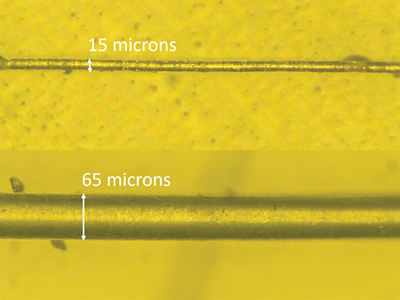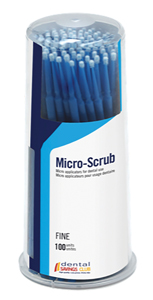In order to achieve long-lasting adhesive restorations, each detail in the bonding process must be considered. One often over-looked aspect of bonding is the step in which the bonding agent is agitated while being placed on the tooth. Manufacturers of dental bonding agents will often recommend a 10-20 second application time of the adhesive, during which agitation is most commonly recommended. Agitation of the bonding agent serves many functions beyond just spreading the bonding agent to all surfaces of the preparation.
One function of agitating an adhesive is to help dissolve the smear layer. The smear layer is a layer of cutting debris that may be a few microns thick that is left on the enamel and dentin after tooth preparation.1 Application of phosphoric acid before bonding dissolves the smear layer. When using a self-etch adhesive, however, this smear layer must be partially solubilized and incorporated into the dentin hybrid layer. A laboratory study reported that self-etch adhesive applied with agitation achieved higher bond strength than when applied passively. In microscopic evaluation, when adhesive was applied with agitation, the smear layer was completely dispersed or dissolved and a thick hybrid layer was formed with upstanding collagen fibrils. When the adhesive was applied passively, the adhesive diffused through the smear layer to form only a thin hybrid layer.2
Other studies have also reported that agitation of the adhesive will improve the bond to dentin.3-6 Adhesive application may refresh the adhesive on the bonding surface, evaporate solvent, help infiltrate the resin into the demineralized collagen, and disperse air bubbles trapped in bonding agent. One study reported that vigorous agitation improved the bond more than slight agitation on dry dentin.6 Some studies have also reported that agitation of self-etch adhesives may also improve bond strength to enamel, although, the etch pattern was still less distinct than that achieved with phosphoric acid.7,8 Agitation of the phosphoric acid etchant can also improve bond strength.9
The tools used to agitate adhesives are commonly different forms of brushes. These brushes may either be in the form of bristle brush applicators, Micro Scrub applicators or brushes attached to the dispensing tip. (Fig. 1) Bristle brush applicators are useful for applying adhesive into small spaces as individual bristles may penetrate into very small spaces as thin as the width of a single bristle (65 microns). (Fig. 2) There are several disadvantages of bristle brush applicators however. Since the bristles are bendable, it can be hard to control the placement of the bristles and adhesive may be inadvertently applied outside the tooth preparation. As the bristles are bunched together, it can be difficult to visually assess how much adhesive is present on the brush. And finally, the length of the bristles can block the view of the operator when determining if the ends of the bristles have contacted the bonding surface.
Fig. 1

Fig. 2

Micro-Scrub applicators are commonly used to apply adhesive. These micro applicators are composed of a plastic handle with 15 micron fibers (Fig. 2) inserted into the head of the handle. Selection of a micro applicator of the necessary size can affect the efficiency and quality of an adhesive restoration.
Although the fibers on a micro applicator are very fine, the fibers may insert into a head that is slightly larger than the tip of the handle. Therefore, micro applicators are available in different sizes based on their intended clinical use. For example, the Micro-Scrub applicators (Dental Savings Club) are available in a regular, fine and super fine. (Fig. 3) The width at the tip of the applicators are 1.6 mm for the regular, 1 mm for the fine and 0.5 mm for the super fine. The regular sized applicators are useful for application of adhesive into tooth preparations. The size of the head allows more bristles which can efficiently carry sufficient adhesive into the preparation. (Fig. 4) For example, the regular size applicator holds .035g of adhesive, the fine holds .015g of adhesive, and the super fine holds .005g of adhesive. The increased numbers of bristles that can vary between 40,000 bristles ( Standard) to 30,000 bristles on the super fine will also allow efficient agitation of the adhesive. The smaller sized micro-scrub applicators can be used when there is less space, such as smaller preparations and root canal spaces.
Fig. 3A

Fig. 3B

Fig. 3C
Fig. 3D

Fig. 4

The ability to prepare conservative tooth preparations is a clinical advantage of using bonded resin composite restorations. However, if the adhesive is not adequately applied, the quality of the adhesive bond will be compromised. Therefore, the use of fine or micro fine Micro-Scrub (Dental Savings Club) applicators may be necessary to adequately apply and agitate adhesive in conservative preparations, such as those used for preventive resin restorations, slot preps, and small Class III composites.
Application and agitation of adhesive into an access opening and root canal space is necessary for bonding a post and core. The bond to root canal dentin is significantly improved when excess adhesive is removed and the solvent is evaporated.10 The largest diameter of the access cavity is approximately 1.2-1.5mm for maxillary incisors and 0.6-1.8mm for mandibular incisors.11 Therefore, the use of a super fine micro scrub applicator may help to deliver adhesive to the post space.
Although micro applicators may seem like a trivial tool in the scheme of a dental procedure, the use of a quality micro applicators may affect the outcome and ease of an adhesive procedure. A potential disadvantage of the use of a non-quality micro applicator is loss of fibers in the adhesive. For demonstration, a micro applicator used for cosmetic purposes was soaked in dental adhesive for 3 seconds and then rubbed against a glass microscope slide. Many fibers were dislodged from the handle and became immersed into the adhesive. (Fig. 5) If this micro applicator was used clinically, the dislodged fibers would have contaminated the bond with the tooth structure. For further demonstration, the micro applicators used for cosmetics and a quality micro applicator (Micro-Scrub, Dental Savings Club) were soaked in laboratory grade acetone. After 20 minutes, all fibers had dislodged from the cosmetic brush where the fibers remained in the quality Micro-Scrub after 24 hours of soaking in acetone.
Fig. 5A

Fig. 5B

Another feature which may differentiate a micro applicator is the ability to bend its handle without fracture. (Fig. 5B) Bending the handle of a micro applicator is useful in order to apply adhesive in hard to reach areas of a preparation. Micro applicator handles may also be bent in order to differentiate the purpose of two different brushes (for example, a bent brush for primer and a straight brush for adhesive). Non-quality micro applicator may have brittle plastic handles that fracture when attempting to bend them.
In summary, application and agitation of adhesive is an important step for adhesive bonding. Micro applicator have advantages over bristle brushes for achieving this task due to their ability to achieve better control and visualization. Larger sized brushes are more efficient at delivering adhesive whereas smaller brushes may be placed into smaller sized spaces. The use of quality micro applicator is recommended as they will not lose fibers and they can be bent without fracture.
Oral Health welcomes this original article.
References
- Pashley DH. Dentin: a dynamic substrate—a review. Scanning Microsc. 1989 Mar;3(1):161-74; discussion 174-6. PMID: 2662395.
- Chan KM, Tay FR, King NM, Imazato S, Pashley DH. Bonding of mild self-etching primers/adhesives to dentin with thick smear layers. Am J Dent. 2003 Oct;16(5):340-6. PMID: 14677614.
- do Amaral RC, Stanislawczuk R, Zander-Grande C, Gagler D, Reis A, Loguercio AD. Bond strength and quality of the hybrid layer of one-step self-etch adhesives applied with agitation on dentin. Oper Dent. 2010 Mar-Apr;35(2):211-9. doi: 10.2341/09-198-L. PMID: 20420065.
- do Amaral RC, Stanislawczuk R, Zander-Grande C, Michel MD, Reis A, Loguercio AD. Active application improves the bonding performance of self-etch adhesives to dentin. J Dent. 2009 Jan;37(1):82-90. doi: 10.1016/j.jdent.2008.09.010. Epub 2008 Nov 13. PMID: 19013000.
- Miyazaki M, Platt JA, Onose H, Moore BK. Influence of dentin primer application methods on dentin bond strength. Oper Dent. 1996 Jul-Aug;21(4):167-72. PMID: 8957907.
- Reis A, Pellizzaro A, Dal-Bianco K, Gones OM, Patzlaff R, Loguercio AD. Impact of adhesive application to wet and dry dentin on long-term resin-dentin bond strengths. Oper Dent. 2007 Jul-Aug;32(4):380-7. doi: 10.2341/06-107. PMID: 17695611.
- Cehreli SB, Eminkahyagil N. Effect of active pretreatment of self-etching primers on the ultramorphology of intact primary and permanent tooth enamel. J Dent Child (Chic). 2006 May-Aug;73(2):86-90. PMID: 16948369.
- Ando S, Watanabe T, Tsubota K, Yoshida T, Irokawa A, Takamizawa T, Kurokawa H, Miyazaki M. Effect of adhesive application methods on bond strength to bovine enamel. J Oral Sci. 2008 Jun;50(2):181-6. doi: 10.2334/josnusd.50.181. PMID: 18587208.
- Faria-e-Silva AL, Silva JL, Almeida TG, Veloso FB, Ribeiro SM, Andrade TD, Vilas-Boas BV, Martins MC, Menezes MS. Effect of acid etching time and technique on bond strength of an etch-and-rinse adhesive. Acta Odontol Latinoam. 2011;24(1):75-80. PMID: 22010410.
- Thitthaweerat S, Nakajima M, Foxton RM, Tagami J. Effect of solvent evaporation strategies on regional bond strength of one-step self-etch adhesives to root canal dentine. Int Endod J. 2013 Nov;46(11):1023-31. doi: 10.1111/iej.12093. Epub 2013 Mar 22. PMID: 23521044.
- Krapež J, Fidler A. Location and dimensions of access cavity in permanent incisors, canines, and premolars. J Conserv Dent. 2013 Sep;16(5):404-7. doi: 10.4103/0972-0707.117491. PMID: 24082567; PMCID: PMC3778620.
About the Author
 Nathaniel Lawson is an Associate Professor and Director of the Division of Biomaterials at the UAB School of Dentistry. Additionally, he is the director of a 2 year Biomaterials residency program. He is passionate about testing new materials and techniques in the laboratory and applying the results to clinical dentistry. His primary research interests are related to the physical and mechanical properties of dental ceramics, composites, cement, and adhesive.
Nathaniel Lawson is an Associate Professor and Director of the Division of Biomaterials at the UAB School of Dentistry. Additionally, he is the director of a 2 year Biomaterials residency program. He is passionate about testing new materials and techniques in the laboratory and applying the results to clinical dentistry. His primary research interests are related to the physical and mechanical properties of dental ceramics, composites, cement, and adhesive.
 Dr Krisha Shah is a resident in the Biomaterials program at the UAB School of Dentistry.
Dr Krisha Shah is a resident in the Biomaterials program at the UAB School of Dentistry.













